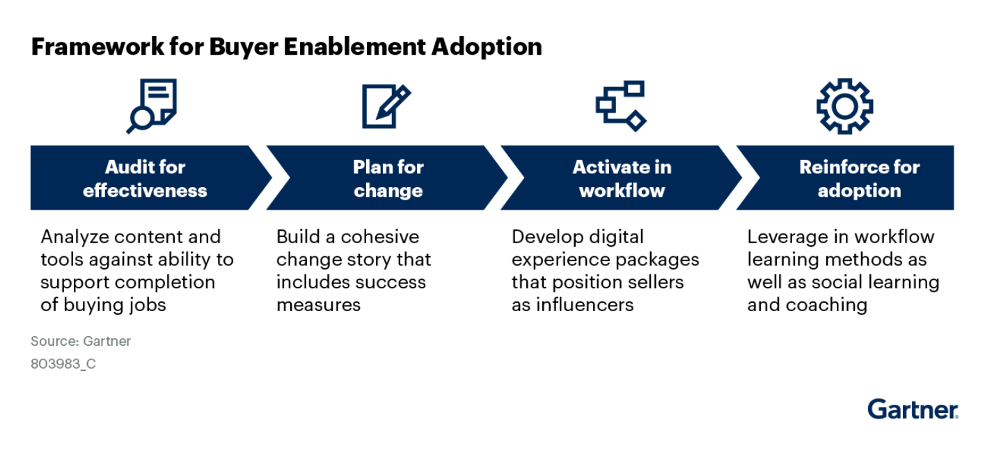
Sellers often struggle to adapt to evolving buyer behaviors and expectations, and remain limited by outdated enablement strategies that prevent them from having meaningful connections with buyers. Furthermore, a disjointed relationship between sales and marketing leads to insufficiently developed buyer enablement content and tools that provide sellers lackluster support when engaging buyers, negatively impacting seller adoption as well as increasing buyer friction.
So how can sales enablement leaders drive the adoption of digital buyer enablement content and tools while generating alignment between the changing buying landscape and enhanced seller-led interactions?
Leaders will need to create a framework that addresses both buyer enablement content and tool adoption that is activated through technology and reinforced through coaching and in-workflow guidance.
To help sales enablement leaders strengthen seller-led interactions by tapping into digital buyer enablement content and tools, Gartner recommends focusing on a four-step plan. (see Figure 1):

Step 1. Audit Buyer Enablement to Measure its Effectiveness
Sales enablement leaders should collaborate with sales and marketing functions to audit current buyer enablement content and tools, asking the question “How does this content allow buyers to confidently complete buying tasks?” This is a critical step in driving future adoption.
Leaders must then align with these functions to measure content and tools’ support of delivering value clarity to buyers in the buying journey. Sellers deliver on value clarity through two variables: value framing (helping buyers understand how to use a solution to improve their job or company performance) and value affirmation (helping buyers validate that a purchase is right for them and to feel confident in their decision). Ask questions ranging from, “What are the tasks buyers must complete during the purchase, and what questions do they ask of themselves” to “How do sellers provide value framing and value affirmation to buyers based on buyer needs” to “What revenue technologies will sellers employ?”
At this point, leaders can now identify gaps in existing content, tools and technology as well as establish a connection between buying jobs and sellers’ ability to support those jobs.
Step 2. Gain Seller Buy-In by Planning for Change
Once gaps have been identified, sales enablement leaders must create and communicate a change story, as well as a roadmap with a compelling narrative, outlining required resources, timing and indicators of success. This is instrumental in encouraging seller buy-in and providing clarity around your transformational goals.
Step 3. Activate Content and Tools into Seller Workflows
Next, leaders should activate content and tools by building digital experience packages that integrate buyer enablement content and tools and revenue technology, allowing for collaborative relationships between sellers and technology. These packages enable sellers to stay within their workflow while supporting buyer needs.
By creating collaborative digital experience opportunities, enablement provides sellers with the ability to positively influence the buying journey and demonstrate:
- Contextual understanding — Through technology, sellers can identify and harness deeper insights into buyer behaviors, allowing for customization in every engagement.
- Adaptive engagements — In response to changing buyer needs, sellers can be nimble and provide in-the-moment adjustments to engagement strategies.
- Proactive contributions — Sellers are positioned as proactive problem solvers and experts, utilizing technology to surface the appropriate sales tool solutions.
Step 4. Reinforce to Drive Seller Adoption
As a final step, sales enablement leaders should help drive adoption through reinforcement strategies that encourage seller behavior change, such as in-workflow guidance and social learning.
In-workflow guidance provides personalized support as prompts within seller workflows, enabling them to arm buyers with necessary information to progress through a deal. These prompts can include behavioral nudges that lead to a desired action to just-in-time (JIT) learning centered around delivering information at the moment of need.
Through social learning, leaders should establish a dynamic knowledge exchange that collaboratively expands upon collective best practices and shared intelligence.
By focusing on this four-step plan, sales enablement leaders can transform buyer enablement and empower sellers to leverage and reinforce new content and tools in response to an evolving buying landscape. This framework will ultimately result in enhanced seller-led interactions that align with buyer needs.
Alyssa Cruz is a senior principal analyst in the Gartner Sales Practice, focused on various sales enablement and strategy topics. Join Alyssa to learn more about sales enablement planning at the Gartner CSO & Sales Leader Conference, May 21-22, in Las Vegas.
Get our newsletter and digital focus reports

Stay current on learning and development trends, best practices, research, new products and technologies, case studies and much more.



